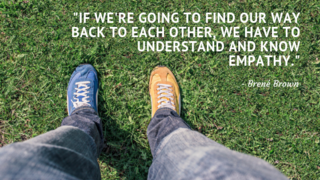Empathy
How Children Develop Empathy
Empathy is a work-in-progress throughout childhood and adolescence.
Posted May 9, 2019 Reviewed by Gary Drevitch
“My 3-year-old doesn’t seem very empathetic. Does this mean something is wrong?”
“Someone told me that kids can’t 'do' empathy until age 9. Is that true?”
These are examples of the types of questions parents often send us. There is good reason for confusion around the topic of empathy. While it is clear that empathy is important for the development of healthy social relationships and character traits like caring and kindness, it isn’t necessarily something that your child “has” or “doesn’t have” by a certain age. There isn’t a clear set of checkboxes you can mark or a definitive test you can take to make sure your child is on track to develop empathy.

Indeed, observing a preschooler closely—especially with an eye out for more “grown-up” versions of empathetic responses—can be a bit disconcerting. Of course, there are times when empathy can show up in unmistakable ways. Just last week, I was touched when my son’s preschool teacher emailed me a picture of him offering a hug to a little girl in his class who was having a hard time. “There it is!” I thought proudly. “Empathy!” This warm glow cooled significantly just a few hours later when this same little angel watched his brother topple head over heels on the sidewalk. When we pointed out that the giant tears streaming down his brother’s face told us his baby brother was sad and scared, my older child responded by running in circles with his hands over his ears chanting, “That’s funny!” over and over again.
If, however, you can get past your own parental horror and look closer, it is clear that in both instances my older son had an emotional response to another person’s distress. The roots of empathy start there. Knowing how to handle those big feelings and translate them into behaviors that can truly serve another person is a far more complex task, one that requires both maturation and practice.
Empathy means that a child:
- Understands that she is a distinct person from those around her and that other people may have different feelings and perspective than her own.
- Can recognize feelings in herself and others and name them.
- Can regulate her own emotional responses.
- Can put herself in someone else’s shoes and imagine how someone might feel.
- Can imagine what kind of action or response might help a person feel better.
That’s a lot of work. Empathy is a work-in-progress throughout childhood and adolescence and is shaped by a range of factors including genetics, temperament, context, and environment. Empathy does not, however, simply unfold automatically in children. While we are born hardwired with the capacity for empathy, its development requires experience and practice.
Emotional Foundations
Empathy is both an emotional and cognitive experience. The emotional components of empathy are the first to emerge. Babies begin reflecting the emotional states and expressions of those around them right away. Thanks to mirror neurons, infants as young as 18 hours old often show some responsiveness to other infants in distress. We don’t teach babies how to do this; they are born hardwired to map the experiences of others in their brains and bodies.
Early emotional experiences between babies and their caregivers are crucial to the development of empathy. As caregivers nurture and care for infants, babies make crucial associations between positive human interactions, reward systems, and feelings of calm and safety. Children who feel safe, secure, and loved are eventually more sensitive to others' emotional needs. Psychologists call this connection between caregivers and babies “attachment” and research shows that quality of attachment is a predictor of empathy and compassion later in life.
Feeling and Thinking
As children get older, the cognitive components of empathy begin to emerge and complement the emotional templates they formed during the first years of life. By the preschool years, children become more aware that other people have separate bodies, feelings, and experiences. They develop what is called a “theory of mind,” which enables them to engage in early “perspective taking,” a precursor to being able to stand in someone else’s shoes and care about what that feels like. The distinction between self and other matures quickly throughout early childhood. For example, if a one-year-old sees that a friend is upset he may go get his own mother to comfort him. A two-and-a-half-year-old in the same situation may get his friend’s mother because he now understands that his friend would want his own parent in a time of distress. Of course, these interactions are still in the very early stages of development and are limited to situations that toddlers have experienced themselves, guided by responses modeled by adults who care for them.
Cognitive components of empathy really come into their own by six or seven, when a child is more capable of taking another person's perspective and offering solutions or help when they notice someone in distress. As children's executive function skills mature and they become more capable of managing their own distress, they gain the "cognitive space" they need to connect with another person's experience without feeling totally overwhelmed themselves. All of this practice is a foundation for the complex ethical and moral issues that young people begin to take on like bullying, inequality, or racism.
"Empathy is caught, not taught."
Of course, these skills and behaviors unfold differently for different children and depend upon context as well. A tentative preschooler who feels safe and secure halfway through the school year may be well poised to be an empathetic friend. The first day of school? Maybe not so much. But all of these moments are opportunities to create the conditions for empathy and plant seeds we hope will grow. We can’t sit our children down for formal lessons in empathy. Instead, empathetic responses emerge over time in the context of caring relationships, modeling, storytelling, communication, playing, emotion coaching, and a whole lot of patience. As Mary Gordon, the founder of Roots of Empathy, reminds us, “Empathy is caught, not taught.”
See our previous posts for tips on nurturing empathy throughout early childhood and into adolescence.
References
Mikulincer, M., Shaver, P. R., Gillath, O., & Nitzberg, R. A. (2005). Attachment, Caregiving, and Altruism: Boosting Attachment Security Increases Compassion and Helping. Journal of Personality and Social Psychology, 89(5), 817-839.
Astington JW, Dack LA. Theory of mind. In: Haith MM, Benson JB, eds. Encyclopedia of infant and early childhood development. Vol 3. San Diego, CA: Academic Press; 2008: 343-356.
Szalavitz, M., & Perry, B. D. (2010). Born for love: Why empathy is essential-- and endangered. New York: William Morrow.
Decety, Jean, and Kalina J. Michalska. "Neurodevelopmental changes in the circuits underlying empathy and sympathy from childhood to adulthood." Developmental science 13.6 (2010): 886-899.
Findlay, Leanne C., Alberta Girardi, and Robert J. Coplan. "Links between empathy, social behavior, and social understanding in early childhood." Early Childhood Research Quarterly 21.3 (2006): 347-359.
Cox, C. L., Uddin, L. Q., Di Martino, A., Castellanos, F. X., Milham, M. P., & Kelly, C. (2011). The balance between feeling and knowing: affective and cognitive empathy are reflected in the brain's intrinsic functional dynamics. Social cognitive and affective neuroscience, 7(6), 727–737. doi:10.1093/scan/nsr051




